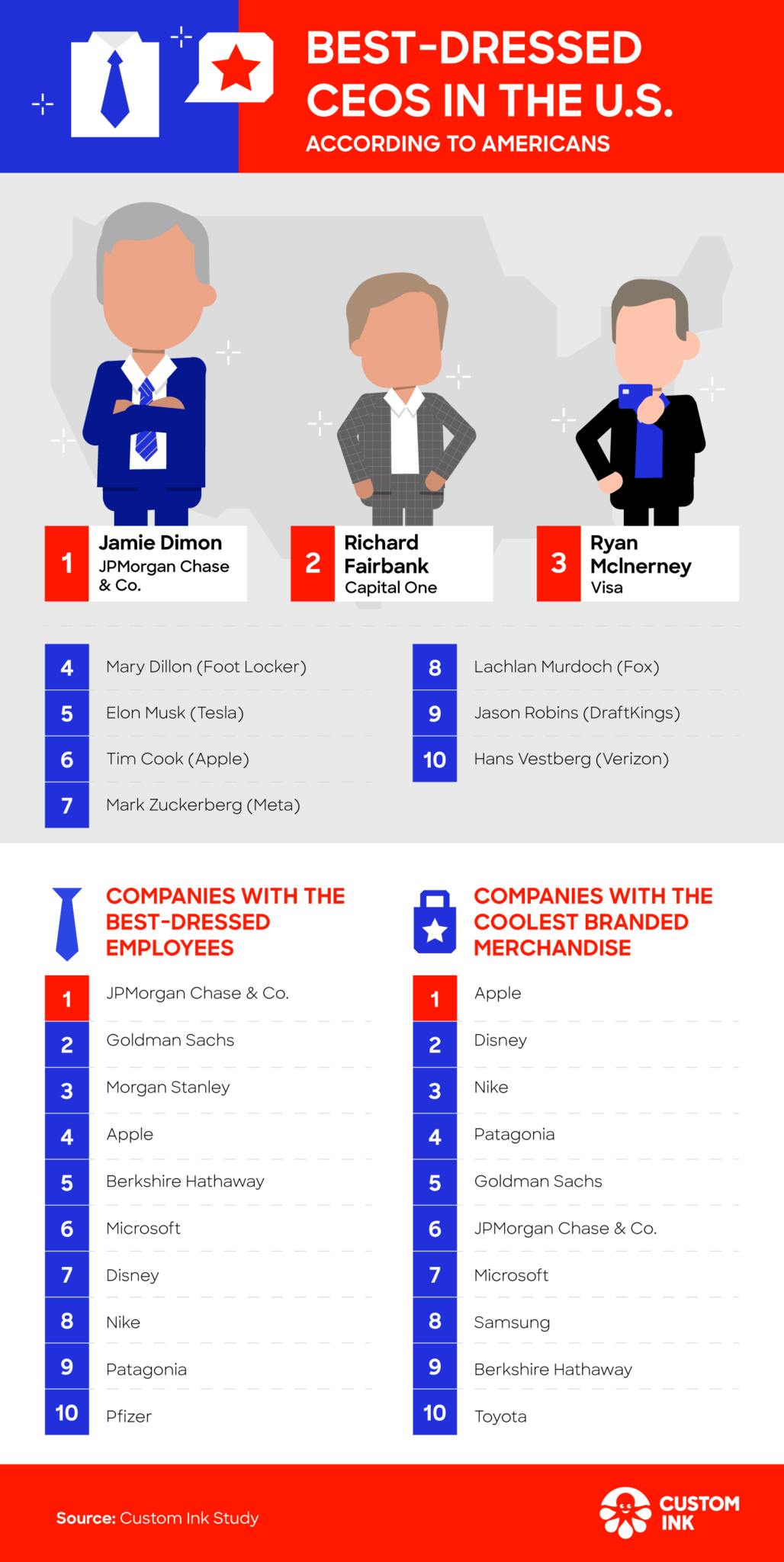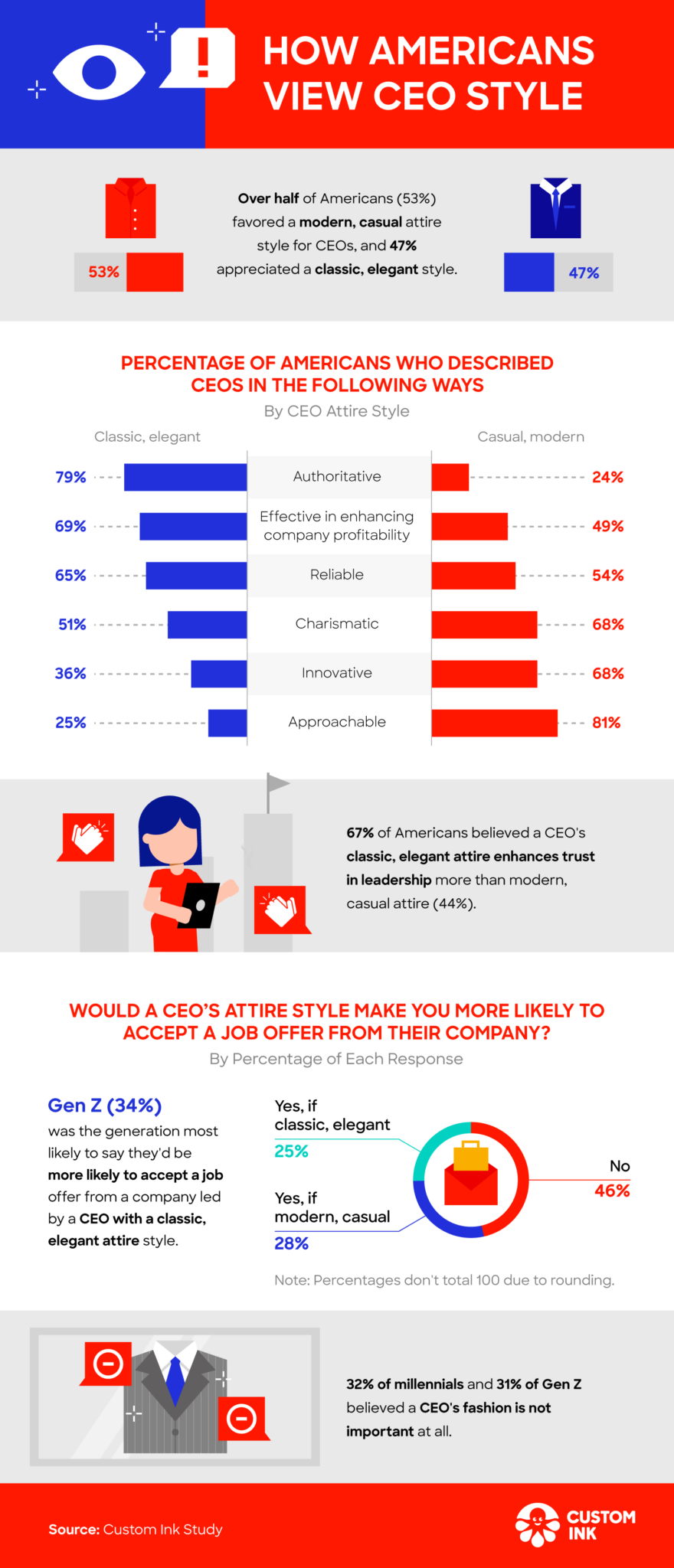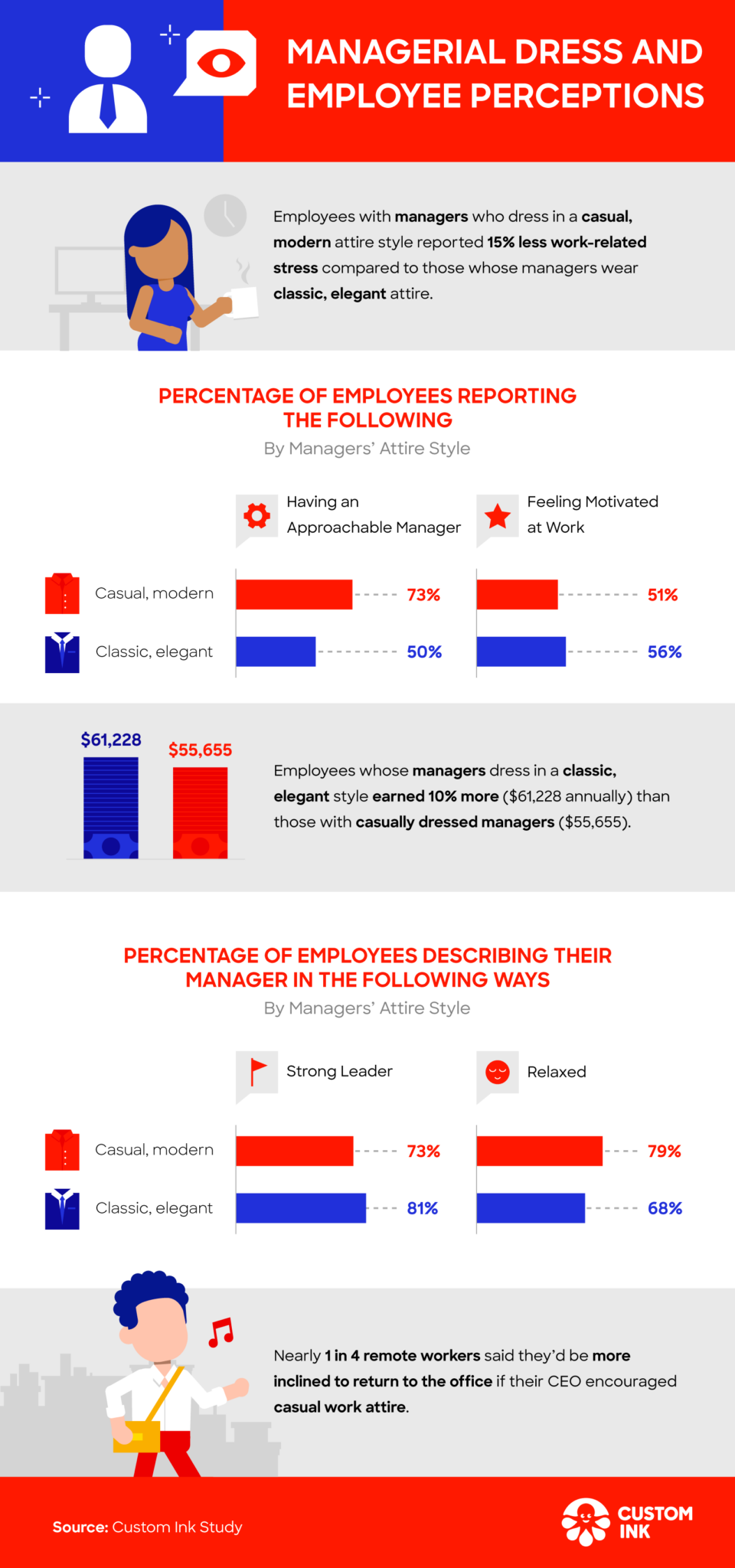Dressing the Part: The CEO Style Effect
 Have you ever thought about how a CEO’s outfits affect how their employees (and the whole world) see them and their company? To find out more about the CEO style effect, we surveyed over 1,000 Americans about whether they prefer their business leaders in sharp suits or cool, casual gear. We also used the opportunity to search for America’s best-dressed CEO, exploring how executives’ fashion choices play into the workplace vibe and how they’re perceived. Ready to see how what you wear can speak volumes about your leadership and influence? Let’s get into the highlights of our study.
Have you ever thought about how a CEO’s outfits affect how their employees (and the whole world) see them and their company? To find out more about the CEO style effect, we surveyed over 1,000 Americans about whether they prefer their business leaders in sharp suits or cool, casual gear. We also used the opportunity to search for America’s best-dressed CEO, exploring how executives’ fashion choices play into the workplace vibe and how they’re perceived. Ready to see how what you wear can speak volumes about your leadership and influence? Let’s get into the highlights of our study.
Key Takeaways
- Americans believe Jamie Dimon (JPMorgan Chase & Co.) is the best-dressed CEO in America.
- Americans believe JPMorgan Chase & Co. and Goldman Sachs have the best-dressed employees in the U.S.
- The finance industry has the best-dressed CEOs in the U.S.
- CEOs dressed in casual, modern attire are perceived as 224% more approachable than those in classic, elegant outfits.
- Employees with managers who dress in a casual, modern attire style reported 15% less work-related stress than those whose managers wear classic, elegant attire.
- Employees whose managers dress in a classic, elegant style earn 10% more than those with casually dressed managers ($61,228 and $55,655, respectively).
- Nearly 1 in 4 remote workers would be more inclined to return to in-office if their CEO encouraged casual work attire.
Dressed for Success
Right off the bat, we’re unpacking the style choices of America’s CEOs and how they impact corporate identity. We distinguish between classic, tailored elegance — think well-fitting suits, dress shirts, and formal shoes — and modern, casual wear, with relaxed options like jeans or chinos with sneakers and maybe the occasional blazer to spruce them up.




Our survey participants crowned Jamie Dimon of JPMorgan Chase & Co. America’s best-dressed CEO. Maybe that’s why his company was also the best dressed based on his employees’ attire. Dimon’s professional attire epitomizes the timeless appeal of classic, tailored elegance.
Goldman Sachs was the second-best-dressed company in the U.S., with an employee dress code that mirrors the refined, professional image of the finance sector. Investment banking company Morgan Stanley ranked third. These insights further cement the finance industry’s reputation for having the best-dressed CEOs overall compared to other industries.
These were the top 5 industries with the best-dressed CEOs:
- Finance
- Niche retailers
- Automotive
- Technology
- Media/Entertainment
A notable mention must be made of Mary Dillon, the newest CEO of Foot Locker. This former Ulta CEO came in fourth and was the only female leader in our study to make America’s top 10 best-dressed CEOs. Meanwhile, Elon Musk clinched the title of the fifth-best-dressed with his minimal approach to personal presentation.
Business vs. Casual
Next, we’ll share how Americans perceive CEO attire, its implications for leadership and approachability, and the key wardrobe pieces that make for the ideal CEO outfit in 2024.
While the power suit is a commanding symbol, executive leaders need to be relatable as well. What they wear can make a big difference in that realm: Only about a quarter of Americans (24%) viewed casually dressed CEOs as authoritative. Instead, those same modern-styled leaders were seen as significantly more approachable—224% more, to be exact—than their more traditionally dressed counterparts.
However, younger generations may be shifting their focus beyond workplace attire. Millennials and Gen Z were most likely to share the perception that a CEO’s fashion sense is a non-priority, signaling a change in what attributes workers value in leadership. This could be due to the rise in remote work, where most people (CEOs and employees alike) can work in their pajamas if they want to, and no one is the wiser.
But when in the public eye, these are the top 10 items Americans believe make up 2024’s ideal CEO outfits:
- Dress shirts (69%)
- Dress shoes (62%)
- Belts (59%)
- Blazers (56%)
- Watches (55%)
- Slacks (43%)
- Ties (40%)
- Polo shirts (36%)
- Briefcases (35%)
- Coats (35%)
Gen Z showed a particular preference for CEOs to wear loafers (41%) and sneakers (33%). Clearly, closed-toed shoes are a must. However, a small 1 in 12 said they should wear sandals, pushing the boundaries of traditional CEO attire. This mix of traditional and modern preferences reflects a trend toward personalized and approachable leadership styles.
Managerial Style and Staff Morale
Beyond the executive suite, how does workplace attire correlate with employee well-being, job satisfaction, and salary? Let’s see how managerial attire might relate to these aspects of work.
After years of remote and hybrid working, many employees are refusing to return to the office. Maybe managers should try changing the dress code: Almost a quarter of remote workers expressed a greater willingness to return to the office if their CEOs encouraged casual work attire. After all, maintaining a business-casual work wardrobe isn’t cheap, and different office attire can reflect different earnings.
For example, employees whose managers wear classic, tailored, elegant attire (like suits, dress shirts, and formal shoes) said they earn $61,228 per year on average. That’s 10% more than employees whose managers wear modern, casual attire ($55,655). Yet, there was a trade-off: Employees with managers who dressed casually reported 15% less work-related stress compared to those whose managers wore more elegant attire.
Perhaps how CEO dress sometimes reflects company culture and management styles, with more relaxed fashions leading to less stressed employees. Still, employees with managers who favor a classic, elegant dress code were more likely to be satisfied with their job (60%) than those with managers who prefer modern attire (56%).
A large majority of the American workers we surveyed — 80% — said they prefer the freedom and comfort of modern, casual attire, especially among those working in hospitality (84%), government (82%), and health care (82%) sectors. Professionals in technology (75%) and finance (74%) were less inclined towards casual dress, perhaps reflecting sector-specific norms and expectations.
Dress Code Dynamics
Our look into CEO fashion reveals a lot about leadership and company culture. It’s clear that both classic and casual styles have their place in various workplaces and industries, but casual wear might just be the key to making CEOs and managers seem more approachable and keeping employees less stressed at work. It seems blending style with comfort could be the next big trend in leadership — because it’s not just about looking good; it’s about fostering a great place to work.
Methodology
For this campaign, we used Amazon MTurk Image Classification and showed images of 50 CEOs to respondents to rate how they dressed using the following scale:
- 1 = Poorly dressed
- 2 = Below average
- 3 = Average
- 4 = Well dressed
- 5 = Exceptionally well dressed
We collected 1,200 responses in total.
We also surveyed 1,007 Americans to explore their perceptions of company-branded merchandise and how they perceive CEOs and managers because of how they dress. Among respondents, 15% were Gen Z, 52% were millennials, 25% were Gen X, and 8% were baby boomers. Our style classifications for this study were as follows:
- Classic, tailored elegance (e.g., suits): This style is characterized by formal attire such as well-fitted suits, dress shirts, and formal shoes.
- Modern, casual wear (e.g., jeans, chinos) This approach favors comfort and relatability, featuring casual but smart options like jeans, chinos, casual blazers, and sneakers.
About Custom Ink
Custom Ink brings your custom gear ideas to life with innovative design tools, exceptional service, and a wide array of quality products, empowering groups to express their unique purpose and unity.
Fair Use Statement
Feel free to share our insights on CEO fashion for noncommercial purposes. Just link back to our page for full access to our study and give credit to our work.



Leave a Comment